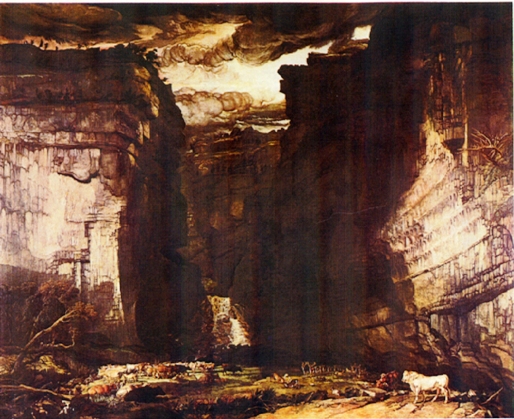Geoscientist 21.03 April 2011

Gordale Scar, about a mile northeast of Malham in North Yorkshire, England, was a locality much loved by Romantic painters of the early 19th Century, and James Ward (1769-1859) – though best known as an animal painter - is a case in point. This large and imaginative canvas, 332cm x 421cm, exhibited today at Tate Britain, London, was created between 1811 and 1815 and was recognised as one of the most astounding depictions of cliffs in British landscape painting at that time. It remains one of the most striking.
Ward was particularly interested in depictions of rural life, and chiefly painted farm animals, under the clear influence of the Dutch painters of the 17th Century. Ward’s artistic education, and the early canvases he painted in the late 1790s could hardly have prepared his audience for this, now famously full-blown Romantic representation of wild nature.
At that time, many believed that it was very difficult – if not impossible - to tackle this kind of geological site from a pictorial point of view. In the art-historical literature, this painting has been more rarely linked to the emerging science of geology than to the Theory of the Sublime, which at that time was widespread throughout Europe and informed much of European landscape painting. The presence of ominous clouds certainly appear to corroborate this idea, recalling landscapes by the 17th Century Italian master Salvatore Rosa, who is generally regarded as the trailblazer of Romantic painting. Nevertheless, the overawing presence of the limestone cliffs clearly evokes the geological world - and to me seems inseparable from the scientific context of the time.
The ‘Scar’ - meaning crag or cliff - is a well-known spot in the Yorkshire Dales National Park. It consists of Carboniferous Limestone (Dinantian, c. 340Ma), formed when northern England lay under a shallow, clear tropical sea abounding in shells and corals. The rocks are ‘realistically’ depicted; the artist carefully representing the stratification near the top of the cliff, where bedding indeed stands out because of contrasts in resistance to weathering in adjacent beds. Also, the correlation of the bedding from left to right hand sides of the scar is fairly accurate.
In the lower part of the cliff on the left-hand side, Ward de-emphasizes bedding. Here the Mountain Limestone seems more massive; vertical elements dominate here, whereas bedding on the right-hand side is emphasized because it is indeed more visible there. However, joint-bed intersections on the left are not, of course, as ‘geologically meaningful’ as would be suggested by the way they have been depicted. The artist's eye emphasizes the way blocks are breaking off at these bedding-joint intersections. One might expect an experienced geologist, sketching this view in a field notebook, to do it rather differently.
Indeed, the artist draws the outcrop in similar to the way debutant geology students might draw before having gained very much experience in making geological sketches grounded in a knowledge of geological theory. Non-geologists, when drawing natural rock faces, will tend to emphasize shadows and erosional irregularities on outcrops, whereas trained geologists tend to emphasize cross-cutting structural relationships that they know are possessed of greater geological ‘meaning’.
This gorge, from which the misfit stream Gordale Beck now emerges, was cut by glacial meltwaters at the end of the Pleistocene Period. It sits on the northern edge of the Craven Fault, an ancient synsedimentary fault with huge (over 900 metre) throws. It is one of the principal geological lineaments defining the Pennines and Yorkshire Dales – and even gains a mention in Charles Darwin’s On the Origin of Species (1859). The breathtakingly high character of the cliffs (they are actually about 80 metres tall) as represented by Ward, evoke the immensity of geological time, providing an early example of the same sort of visual metaphor for Deep Time seen in much later paintings – such as those of William Dyce (1850s).
The presence of a bull at the foot of the cliff provides scale and serves as a comparative measure between the puny, ephemeral animal world and the infinitely greater geological one, towering above and stretching away in time into an unfathomable past, connecting this outstanding picture with the artist’s more prosaic passion for depicting the living animals of his day.
* Dr Alexis Drahos is an art historian specialising in the relationship between painting and the emergence of geology in the late 18th and 19th Centuries. He lives in Paris.